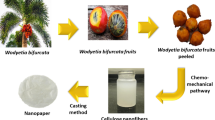Abstract
Thermal degradation behavior and mechanism of aromatic poly(1,3,4-oxadiazole)s fibers (POD fibers) under nitrogen and air were studied. The thermal stability of POD under air and nitrogen was investigated by thermogravimetric analysis, derivative thermogravimetry analysis and differential scanning calorimetry. The results reveal that in the initial stage of thermal decomposition, the thermal degradation behavior under air was the same as that under nitrogen, and in the end stage of thermal decomposition, oxygen had influence on thermal degradation behavior of POD. The changes of macromolecular structure of POD when heated at 500 °C with different times were characterized by Fourier transform infrared, which illustrated that during thermal decomposition process some nitrile groups were formed, implying the disruption of oxadiazole rings. Subsequently, the whole macromolecular chain turned into carbonaceous materials at last. Thermogravimetric analysis–infrared spectra measurement further demonstrated that the carbon dioxide was the main volatilized product and the source of mass loss during thermal decomposition under nitrogen. Disruption of oxadiazole rings and formation of nitrile were further proved by pyrolysis–gas chromatogram–mass spectra characterization. The other characterizations, such as X-ray diffraction, scanning electron micrographs, were also applied to investigate the thermal degradation behavior of POD. According to these results, the mechanism of thermal degradation of POD was proposed.










Similar content being viewed by others
References
Frazer AH, Sweeny W (1964) Poly(1,3,4-oxadiazoles): a new class of polymers by cyclodehydration of polyhydrazides. J Polym Sci (Part A) 2:1157–1169
Frazer AH, Sarasohn IM (1966) Thermal behavior of polyhydrazides and poly-1,3,4-oxadiazoles. J Polym Sci (Part A) 4:1649–1664
Varma IK, Varma DS (1973) Thermal analysis of poly(1,3,4-oxadiazo1e-2,5-diy1-1,4-phenylene) and poly(1,3-phenylene-l,3,4-oxadiazole-2,5-diyl-l,4-phenylene. Die Makromolekulare Chemie 170:117–130
Yang NC, Chang S, Suh DH (2003) Synthesis and optically acid-sensory properties of novel polyoxadiazole derivatives. Polymer 44:2143–2148
Gomes D, Roeder J, Nunes SP (2008) Single-step synthesis of sulfonated polyoxadiazoles and their use as proton conducting membranes. J Power Sources 175:49–59
Yang NC, Suh DH (2003) Synthesis and properties of new ultraviolet-blue-emissive fluorene-based aromatic polyoxadiazoles with confinement moieties. J Polym Sci (Part A) 41:674–683
Janietz S, Anlauf S, Wedel A (2002) A new class of organosoluble rigid-rod, fully aromatic poly(1,3,4-oxadiazole)s and their solid-state properties, 2. solid-state properties. Macromol Chem Phys 203:433–438
Zhu S, Brehmer L, Schulz B (1996) Comparative study of the thermal properties of related aromatic polyhydrazides and poly(1,3,4-oxadiazole)s. Polym Adv Technol 7:879–887
Gomes D, Nunes SP, Borges C (2003) Synthesis and characterization of flexible polyoxadiazole films through cyclodehydration of polyhydrazides. Polymer 44:3633–3639
Hsiao SH, Chiou JH (2001) Aromatic poly(1,3,4-oxadiazole)s and poly(amide-1,3,4-oxadiazole)s containing ether sulfone linkages. J Polym Sci (Part A) 39:2271–2286
Mansoori Y, Sarvari R, Imanzadeh GH (2010) Thermally stable polymers based on 1,3,4-oxadiazole rings. Chin J Polym Sci 28:21–28
Calandrelli L, Pace ED, Laurienzo P, Volpe MG (1994) A new class of aromatic poly-ether-aroyl-oxadiazoles. II. Studies on the cyclization reaction, infrared, structural, and morphological characterization. J Polym Sci (Part B) 32:1249–1256
Murakami M, Mizogami M (1990) Thermal decomposition and carbonization mechanism of poly-para-phenyleneoxadiazole. J Polym Sci (Part A) 28:1483–1493
Zhang ZX, Ye GD, Xu JJ (2007) Influence of cyclodehydration on formation and properties of poly(p-phenylene-1,3,4-oxadiazole) fibre. Plast Rubber Compos 36:343–349
Zhang ZX, Ye GD, Xu JJ (2009) Influence of sulfuric acid bath on morphological structure and mechanical properties of poly(p-phenylene-1,3,4-oxadiazole) fibers. J Appl Polym Sci 114:1485–1493
Rodil SV, Alonso AM, Tascón JMD (2001) Studies on pyrolysis of Nomex polyaramid fibers. J Anal Appl Pyrol 58–59:105–115
Zhang HT (2010) Comparison and analysis of thermal degradation process of aramid Fibers (Kevlar 49 and Nomex). J Fiber Bioeng Inform 3:163–167
Bourbigot S, Flambard X, Poutch F (2001) Study of the thermal degradation of high performance fibres—application to polybenzoxazole and p-aramid fibres. Polym Degrad Stabil 74:283–290
Rodil SV, Paredes JI (2003) Studies on the thermal degradation of poly(p-phenylene benzobisoxazole). Chem Mater 14:4052–4059
Mosquera MEG, Tascón JMD (1994) Thermal transformation of Kevlar aramid fibers during pyrolysis: infrared and thermal analysis studies. Chem Mater 6:1918–1924
Ying HS, Stephen WF, Britton K (1999) A study of poly (benzo[1,2-d:5,4-d‘]bisoxazole-2,6-diyl-1,4-phenylene) reactions at elevated temperatures. Macromolecules 32:6565–6569
Acknowledgments
The financial support of National Natural Science Foundation of China with Grant No. 51303150 is gratefully acknowledged.
Author information
Authors and Affiliations
Corresponding author
Rights and permissions
About this article
Cite this article
Yang, X., Jia, E., Ye, G. et al. Thermal degradation behavior and probable mechanism of aromatic poly(1,3,4-oxadiazole)s fibers. Polym. Bull. 72, 1067–1080 (2015). https://doi.org/10.1007/s00289-015-1322-7
Received:
Revised:
Accepted:
Published:
Issue Date:
DOI: https://doi.org/10.1007/s00289-015-1322-7




